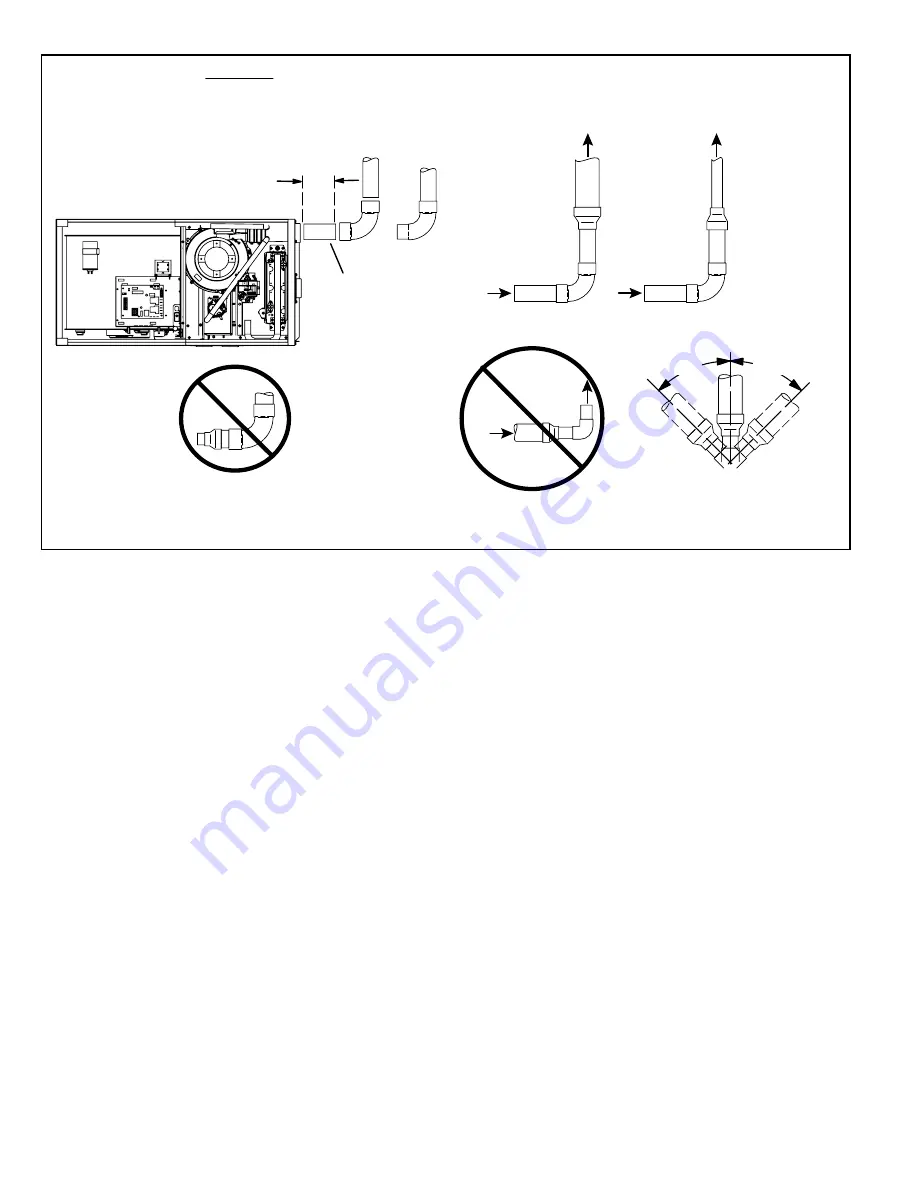
508148-01
Issue 2128
Page 32 of 75
Figure 20.
Typical Exhaust Pipe Connections in Horizontal Direct or Non-Direct Vent Applications
(Right Hand Discharge Shown)
TYPICAL EXHAUST PIPE CONNECTIONS IN HORIZONTAL DIRECT OR NON-DIRECT VENT
APPLICATIONS (RIGHT-HAND DISCHARGE SHOWN)
SIDE VIEW
45°
MAX
45°
MAX
2”
2”
2”
2”
or
2”
12” max.
EXHAUST
TRANSITION
3”
*2”
*2”
EXHAUST
TRANSITION
1-1/2”
2”
2”
EXHAUST
or
NOTE
: 1-1/2” Vent
Pipe Diameter Allowed
Only on 045/070 Units
.
DO NOT transition
from larger to smaller
pipe in horizontal runs
of
exhaust pipe
.
EXHAUST
DO NOT transition
from smaller to larger
pipe in horizontal runs
of
exhaust pipe
.
* When transitioning up in pipe size, use the shortest length of 2” PVC pipe possible.
NOTE
: Exhaust pipe and intake pipe must be the same diameter.
Intake Piping
The A96US2V furnace may be installed in either direct
vent or non-direct vent applications. In non-direct vent
applications, when intake air will be drawn into the furnace
from the surrounding space, the indoor air quality must be
considered and guidelines listed in Combustion, Dilution
and Ventilation Air section must be followed.
Follow the next two steps when installing the unit in Direct
Vent applications, where combustion air is taken from
outdoors and flue gases are discharged outdoors.
The
provided air intake screen must not be used in direct
vent applications (outdoors).
1.
Use transition solvent cement or a sheet metal screw
to secure the intake pipe to the inlet air connector.
2. Route piping to outside of structure. Continue with
installation following instructions given in general
guidelines for piping terminations and intake and
exhaust piping terminations for direct vent sections.
Refer to Table 19A through Table 19B for pipe sizes.
Follow the next two steps when installing the unit in Non-
Direct Vent applications where combustion air is taken from
indoors or ventilated attic or crawlspace and flue gases are
discharged outdoors.
1.
Use field-provided materials and the factory-provided
air intake screen to route the intake piping as shown in
Figure 21 or Figure 22. Maintain a minimum clearance
of 3” (76mm) around the air intake opening. The air
intake opening (with the protective screen) should
always be directed forward or to either side in the
upflow position, and either straight out or downward in
the horizontal position.
The air intake piping must not terminate too close to
the flooring or a platform. Ensure that the intake air
inlet will not be obstructed by loose insulation or other
items that may clog the debris screen.
2. If intake air is drawn from a ventilated attic (Figure 23)
or ventilated crawlspace (Figure 24) the exhaust vent
length must not exceed those listed in Table 19C. If
3” diameter pipe is used, reduce to 2” diameter pipe
at the termination point to accommodate the debris
screen.
3.
Use a sheet metal screw to secure the intake pipe to
the connector, if desired.
















































